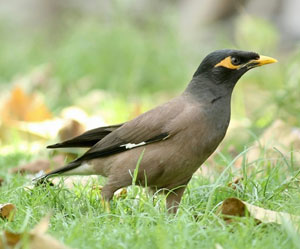Common (Indian) Myna
The Common Myna (Acridotheres tristis) birds were first recorded in the Tweed in 2002. Since then, local populations have grown at a rapid rate.
Also known as Indian Myna or House Myna, they thrive in habitat created by humans, such as urban, industrial and agricultural areas.
Common (Indian) Mynas are a serious threat to the survival of our native wildlife as they are a hollow-nesting bird.
During nesting season, they become very aggressive and take over hollows that would have been used by our hollow-dependent species, such as lorikeets and rosellas, kookaburras and sugar gliders. If a hollow is already occupied, they will evict the occupant, even animals as big as possums.
Invasive species and pest animals are an issue across all of Australia, and everyone can play in role in helping to reduce their impact.
Common Myna Management Program
Council’s Common Myna Management Program encourages community participation through residents trapping the invasive birds on their property. A small number of Common (Indian) Myna traps are available for loan to community members. If you have Common Mynas regularly on your property, and are interested in being part of the solution and controlling this invasive animal in collaboration with Council, contact the Sustainability and Environment Unit on 02 6670 2400 or email indianmyna@tweed.nsw.gov.au.
Introduced pests versus local native honeyeaters
Recognising the Common (Indian) Myna
 Common (Indian) Myna – invasive species.
Common (Indian) Myna – invasive species.The Common (Indian) Myna is a distinctive bird with the following characteristics:
- medium sized chocolate-brown with a black head and neck
- about 25 cm tall
- yellow beak, eye patch, feet and legs
- white wing patches that are obvious when the birds are flying
- walks (or struts) rather than hops.
Our native Noisy Miner
 Noisy Miner – Australian native.
Noisy Miner – Australian native.The Noisy Miner is native to Australia. The native Noisy Miner (Manorina melanocephala) is a honeyeater that is sometimes confused with the Common Myna.
Although the Noisy Miner and the Indian Myna both have yellow skin behind the eye and a yellow beak and legs, you can distinguish the native Noisy Miner by its predominantly grey body.
Noisy Miners can be very noisy around the garden (hence their name!) and they can be territorial, but they are a native protected species that is part of the natural ecosystem, and they do not pose the same threat to our native fauna as the Common (Indian) Myna.
Watch ‘What bird is that? Myna vs. Miner’ for more details on identifying a ‘Myna’ (introduced and invasive) versus a ‘Miner’ (native and protected).
Other Common (Indian) Myna control programs
A local and global problem
Globally, Common (Indian) Mynas are a widely recognised as a serious threat to biodiversity. In 2000, the species was listed among 100 of the World's Most Alien Invasive Species by the World Conservation Union, alongside species such as the fox, the cane toad and the feral pig.
Awareness in Australia is rising about the impacts of the Common (Indian) Myna on our native fauna. During 2004, the Indian Myna was voted the Pest of Australia in the ABC WildWatch Australia survey.
The Common (Indian) Myna is a highly intelligent and aggressive bird that successfully competes with our native species for food and nesting sites. As Common (Indian) Mynas nest in hollows, the negative impacts from this species are particularly high on hollow-dependent mammals and birds.
Other impacts
- Building large untidy nests, using sticks, straw, feathers and rubbish, like scraps of paper and plastic, in roof spaces and cavities, which are a fire risk and an entry point for bird mites into houses. Bird mites bite, and they can cause asthma and hay fever if inhaled.
- Major damage to soft fruit crops such as bananas and papaya.
- The potential to spread weed species. As they consume the fruits of exotic plant species they can assist in the spread of exotic weed species, such as Lantana.
- Consuming feed intended for domestic pets and livestock.
What else can you do?
Other actions you can take to support the Common Myna Management Program:
- Block holes in roofs or eaves to prevent birds from roosting or nesting – make sure you don’t accidentally trap a possum, bat or other native species.
- Feed pets indoors, or clear away food when they’ve finished. Don’t leave compost or rubbish bins uncovered as Common (Indian) Mynas like to scavenge.
- Make sure that birds do not have access to feed intended for your livestock. Where possible, feed livestock only as much as they need at the time, cover the feed bins and clean up any spills.
- Restore disturbed sites with native vegetation that is local to your area to assist in providing habitat more suited to native bird species.
- Use a nest box with a backwards facing entry. This will allow access for small possums, gliders, small bats and some native birds while excluding Common Myna birds.
- Report sightings.
Report Common Myna sightings
The MynaScan community website allows you to report sightings of introduced Common Myna birds and the problems they are causing in your local area.